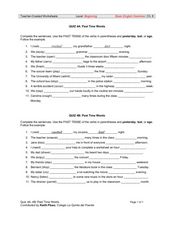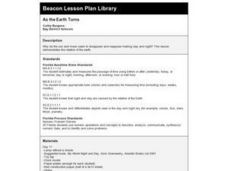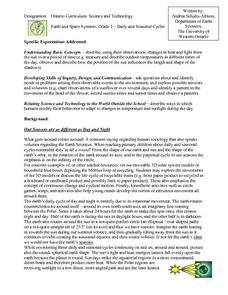Curated OER
Using Time Expressions
In this sentence writing learning exercise, learners practice their sentence building skills. Students put together words to make complete sentences. There are ten items in all to complete.
Curated OER
Past Time Words Quiz 4A
Cut this worksheet in two to have two short quizzes for your class. Either use this as a PDN (Please Do Now) at the beginning of class, or use it as a formal assessment. Each half-sheet provides the learner with 11 sentences to conjugate...
Curated OER
Truth Be Told
Encourage your middle and high schoolers to share their memories of a recent event. After reading a New York Times article, they discuss Elie Wiesel's memoir, Night. They write their own memoir about a significant event that affected...
Curated OER
The Effects of Color on Heat Absorption And Climate
Students conduct an experiment to determine the effects of soil color on its day and night time temperatures. In small groups, they prepare dishes of black soil, brown peat moss, and white sand. They record the temperature changes when a...
Curated OER
What We Eat, Where We Sleep: Documenting Daily Life to Tell Stories
This is not just a New York Time article to read, this is a set of amazing activity ideas all related to the slide shows "Breaking Bread Everywhere" and "Where Children Sleep." Your class can view each show, read about what they mean...
Curated OER
Jonas Salk: He Led the Battle Against Polio
Do you know who Jonas Salk is? Print these pages and have your middle and high schoolers read his biography in Time magazine. The reading itself is short, and it is followed with a key date chart, three reading questions, two connection...
National Center for Case Study Teaching in Science
Mask of the Black God
Finally, an astronomy lesson for the high schooler! Explorers are able to read star maps for finding objects in the night sky by determining celestial coordinates. In particular, they locate the Pleiades and read about a Navajo legend...
Curated OER
Right on Time?
Students share their reactions to hearing a false rumor. After reading an article, they discover how a variety of newspapers responded to printing incorrect information. They prepare their own questions and contact sources for their...
Really Good Stuff
New-Teacher Classroom Set-Up Guide
Packed with teaching tips and best practice ideas from veterans, this 16-page packet is a real boon to new teachers, as well as a great resources for those more experienced professionals. Ideas about how to set up your classroom physical...
Curated OER
St. Patrick
In this St. Patrick worksheet, students read facts about St. Patrick's life, his writing "Confessio", and the meanings of the shamrock and St. Patrick's Day. Students answer eleven fill in the blank questions.
Curated OER
As the Earth Turns
First graders explore why the sun and moon seems to disappear and reappear creating day and night.
Curated OER
Science: Daily and Seasonal Cycles
First graders use their observations to describe daily and seasonal cycles. through a demonstration using a suspended ball and flashlight, they determine the time of day in various locations. Next, 1st graders participate in a...
Curated OER
Roger Robot
Read the story of Roger Robot included in the lesson and have kids move creatively by interpreting how a robot might move. Read a part of the story, then stop and let the class act it out. Read some more, and let them move some more....
Curated OER
Bill Nye Video: Earth's Seasons
For this earth's seasons worksheet, students answer fill in the blank questions after seeing Bill Nye's video. Topics include the rotation of the earth around the sun, the tilt of the earth, the time zones and sunlight.
Curated OER
Flowers Growing Through Music, Rhymes & Movement
First graders experience the growing process of a seed becoming a flower as it is exposed to the sun, rain, wind, day and night, and -tickling- bees as they move creatively to music.
Space Awareness
Sun, Earth and Moon Model
The moon orbits Earth while the Earth is rotating, and the Earth revolves around the sun. This can be a tricky concept for young astronomers. Implement an activity that helps distinguish between the movements of Earth's systems around...
Curated OER
Where Do I Go At Night?
Young scholars describe the requirements of daytime and nightime animals for survival. They identify any behaviors that assist in the animal surviving. They create a representation for the class to view.
Curated OER
Timekeeping by the Sun
Students measure shadows to learn about the Sun-Earth relationship. In this astronomy lesson, students create a shadow stick of a Pokemon character and record measurements of its shadow in a data chart. Follow-up discussions guide...
Curated OER
The Earth's Rotation
Learners see a model of a globe to watch the Earth rotate. In this Earth lesson plan, students rotate the globe and shine a flashlight to see where the sun shines and how it rises and sets. They create a diagram and explain day and night...
Curated OER
Is Your Favorite Time of the Day the Morning, Afternoon, Evening or Night? Bar Graph Recording Sheet
In this bar graph recording worksheet, students receive a numbers and record their preference for morning, afternoon, evening, or night. There are no directions given.
Curated OER
Homeschooling Chronicles: The Benefits of Day Dreaming
Being a day dreamer can bring about creativity and imagination.
University of Texas
Observing the Moon
Why does it look like there is a man on the moon? Why does the moon look different every night? These are the focus questions of a lesson that prompts class members to observe and record the nightly changes of Earth's natural...
Curated OER
The Earth and Beyond
Photographs and graphics bring the solar system and Earth to life in this presentation. Viewers are taken on a virtual field trip, beginning with the sun and planet placement, and proceeding through both Earth and the moon's movements....
Gwinnett County Public Schools
Analysis of the Tuck Everlasting and The Birchbark House Text Exemplars
Looking to introduce some text-based questions into your ELA lessons? Practice the kinds of skills the Common Core demands with the seven text-based questions and the essay prompt provided here. Designed to be a three-day instructional...

























